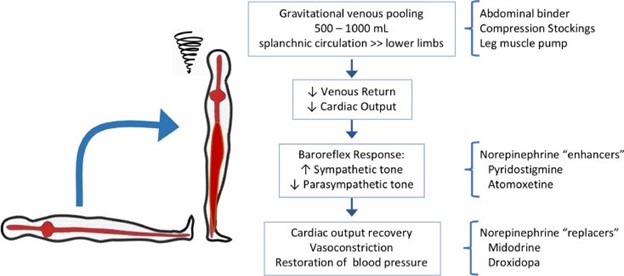A nurse inadvertently administers 160 mg of valsartan PO to a client who was scheduled to receive 80 mg.
Which of the following actions is the priority for the nurse to take?
Monitor the client’s urine output
Check the client for nasal congestion
Evaluate the client for orthostatic hypotension
Obtain the client’s laboratory results
The Correct Answer is C

Nursing Test Bank
Naxlex Comprehensive Predictor Exams
Related Questions
Correct Answer is {"dropdown-group-1":"A","dropdown-group-2":"B"}
Explanation
The nurse should recognize the client is experiencing preterm labor due to previous preterm birth.
Preterm labor is when regular contractions begin to open the cervix before 37 weeks of pregnancy. One of the risk factors for preterm labor is having a previous preterm delivery. The client’s history indicates that her last pregnancy resulted in a preterm spontaneous vaginal birth at 30 weeks gestation. The client’s current symptoms, such as lower back pain, pinkish vaginal discharge, uterine contractions and cervical dilation, also suggest that she is in preterm labor. Therefore, the nurse should recognize that the client is experiencing preterm labor due to previous preterm birth.
BMI, blood type and blood pressure are not causes of preterm labor in this case. BMI may be associated with preterm labor if it is too high or too low, but the client’s BMI is within the normal range for pregnancy. Blood type may cause Rh incompatibility if the mother is Rh negative and the baby is Rh positive, but the client’s blood type is Rh positive. Blood pressure may cause preeclampsia if it is too high, but the client’s blood pressure is normal. Abruptio placentae is a condition where the placenta separates from the uterine wall before delivery, which can cause vaginal bleeding, abdominal pain and fetal distress. The client does not have these signs.
Correct Answer is C
Explanation
This statement should be included in the hand-off report because it provides essential information about the patient’s intraoperative status and potential postoperative complications, such as hypovolemia, anemia, or infection. The estimated blood loss (EBL) is an important indicator of the patient’s fluid balance and hemodynamic stability.
Choice A is wrong because “The client was intubated without complications.” is not relevant for the postoperative care of the patient. The intubation status is usually documented in the anesthesia record and does not need to be repeated in the hand-off report unless there were any issues or injuries related to the airway management.
Choice B is wrong because “There was a total of 10 sponges used during the procedure.” is not pertinent for the postoperative care of the patient.
The number of sponges used during the surgery is usually counted and verified by the scrub nurse and the circulating nurse in the operating room to prevent any retained foreign bodies. This information does not need to be communicated to the PACU nurse unless there was a discrepancy or a missing sponge.
Choice D is wrong because “The client is a member of the board of directors.” is not appropriate for the hand-off report.
This statement violates the patient’s privacy and confidentiality and does not contribute to the quality or safety of care. The patient’s role or position in the organization should not influence the hand-off communication or the postoperative care.
A hand-off report is a critical communication tool that facilitates the transfer of care from one provider to another. It should include relevant information about the patient’s medical history, surgical procedure, intraoperative events, postoperative plan, and any concerns or potential problems.
A standardized hand-off tool, such as SBAR (Situation, Background, Assessment, Recommendation), can help improve the consistency, accuracy, and completeness of the hand-off report.
Some normal ranges that may be useful for postoperative care are:
- Blood pressure: 90/60 mmHg to 120/80 mmHg
- Pulse: 60 to 100 beats/min
- Respiratory rate: 12 to 20 breaths/min
- Oxygen saturation: 95% to 100%
- Temperature: 36°C to 37.5°C
- Hemoglobin: 12 to 18 g/dL
- Hematocrit: 36% to 54%
Whether you are a student looking to ace your exams or a practicing nurse seeking to enhance your expertise , our nursing education contents will empower you with the confidence and competence to make a difference in the lives of patients and become a respected leader in the healthcare field.
Visit Naxlex, invest in your future and unlock endless possibilities with our unparalleled nursing education contents today
Report Wrong Answer on the Current Question
Do you disagree with the answer? If yes, what is your expected answer? Explain.
Kindly be descriptive with the issue you are facing.
